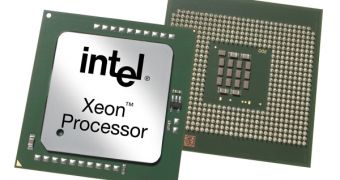Intel has just introduced two new low-voltage offerings to join the Xeon server CPU family. Both chips are based on Intel's 45-nanometer micro-architecture and come in a 50W thermal envelope. The chips are running at maximum core frequencies of 2.5 GHz.
According to the chip manufacturer, the quad-core Xeon L5420 parts are built on Intel's 45-nanometer processing node and come with a significant performance boost over the previous Xeon chips. More than that, the 45-nanometer technology improves the energy-efficiency, which reflects in lower costs while operating data centers.
The benchmarks performed by Intel reveals that the Xeon L5420 processors can deliver 25 percent more performance, as they feature a 50 percent larger cache size than Intel's previous-generation, low-voltage quad-core Intel Xeon processors. The performance improvement, however, does not impact on the chip's thermal design power, thanks to the updated micro-architecture with "re-invented" transistors.
The second chip introduced today is the quad-core Xeon L5410 chip that shares the same basic features with its "older" sibling. The chip comes with 12 MB of on-die cache and a dedicated 1333 MHz front side bus. The only difference between the two processors is the operating frequency. While the Xeon L5420 comes with a default clock speed of 2.5 GHz, the Xeon L5410 counterpart features clock speeds of 2.3 GHz.
"Using Intel's hafnium-infused high-k metal gate transistors has allowed our quad-core 45nm low-voltage server chips to attain new heights in power-efficient performance," said Kirk Skaugen, vice president and general manager of Intel's Server Platforms Group. "These chips deliver the speed needed while using meager amounts of energy," he continued.
Intel is currently shipping more than 35 different server, desktop and mobile processors built on the 45-nanometer micro-architecture with Hafnium-based high-k metal gate technology.

 14 DAY TRIAL //
14 DAY TRIAL //